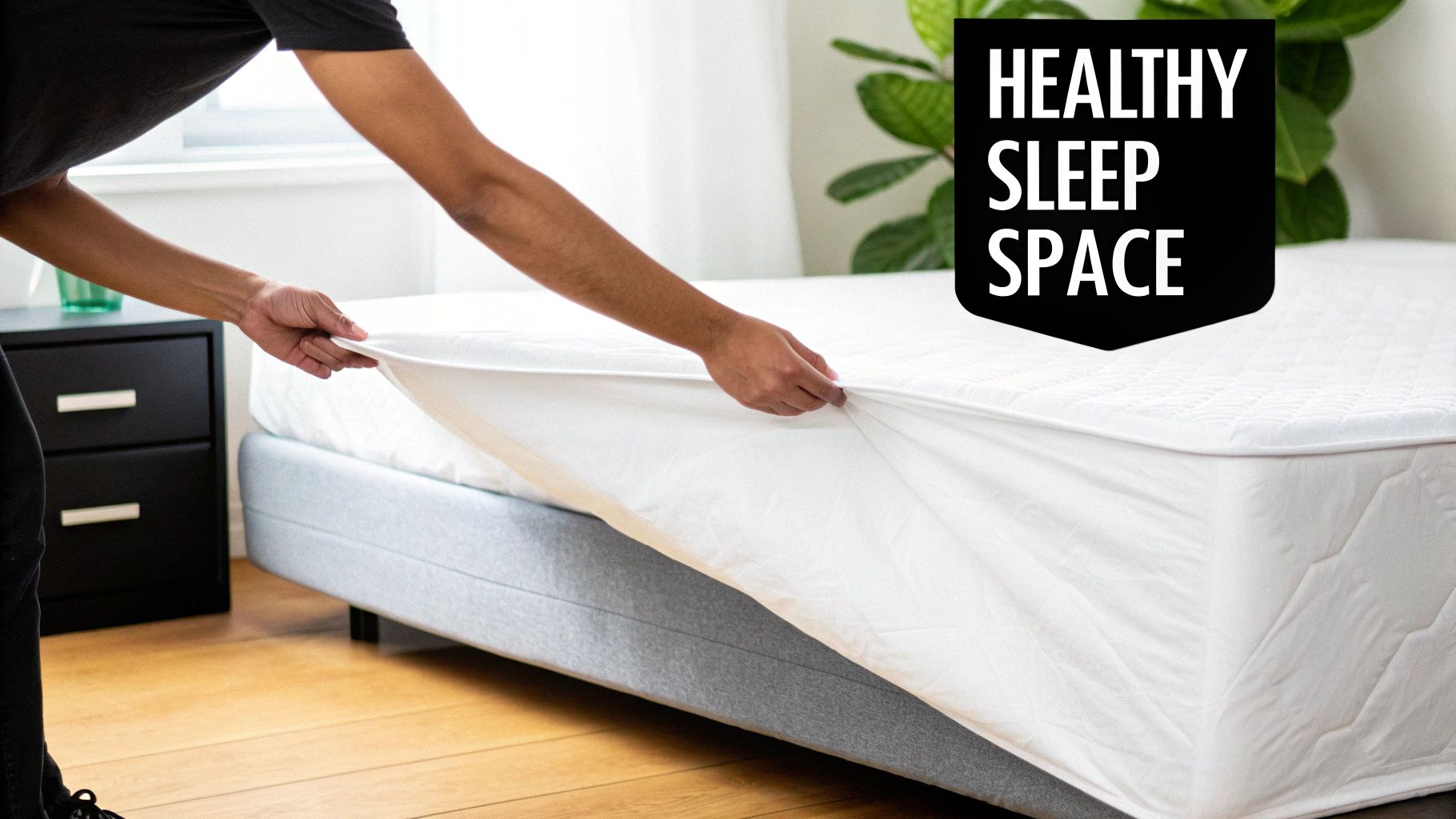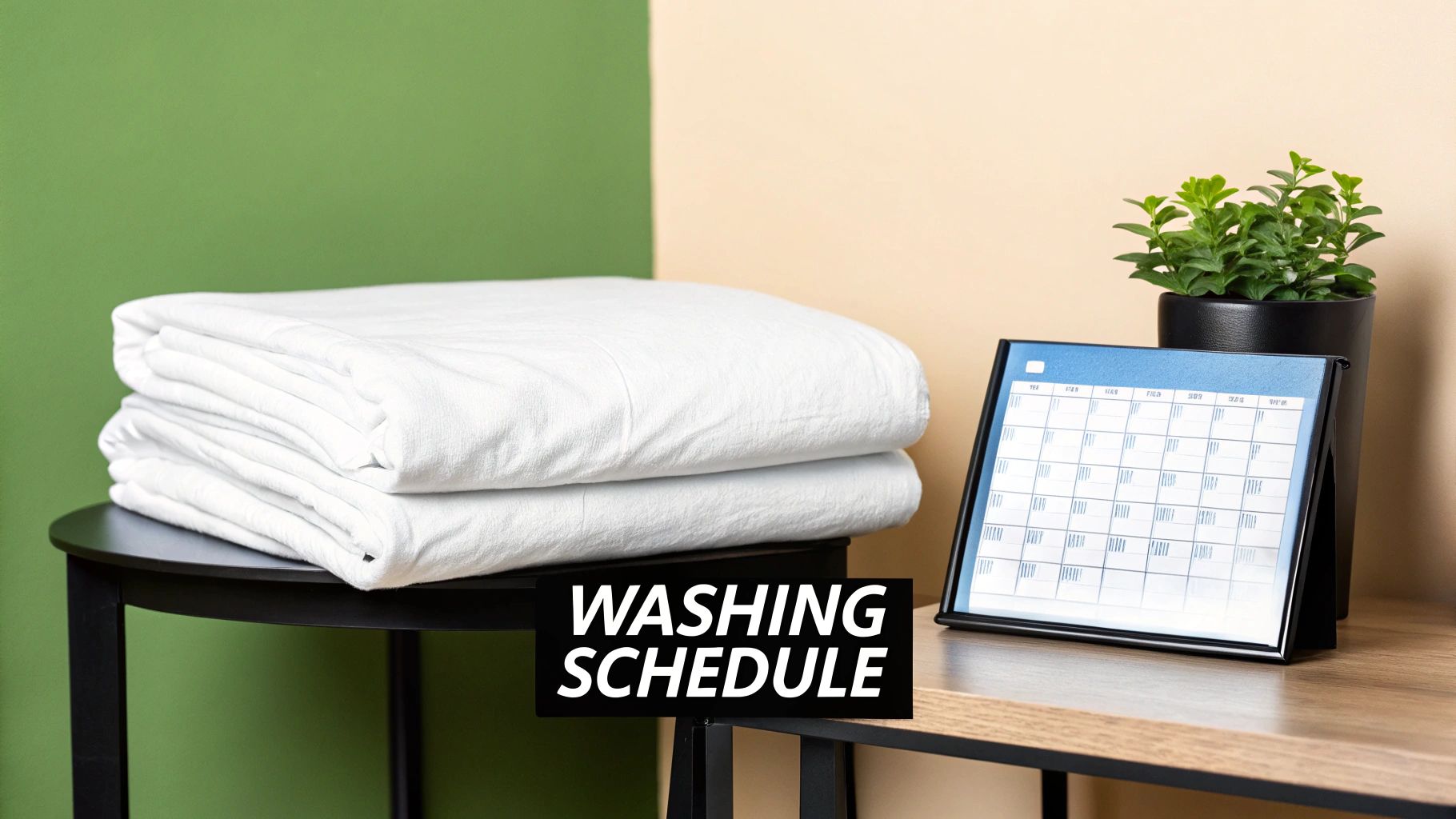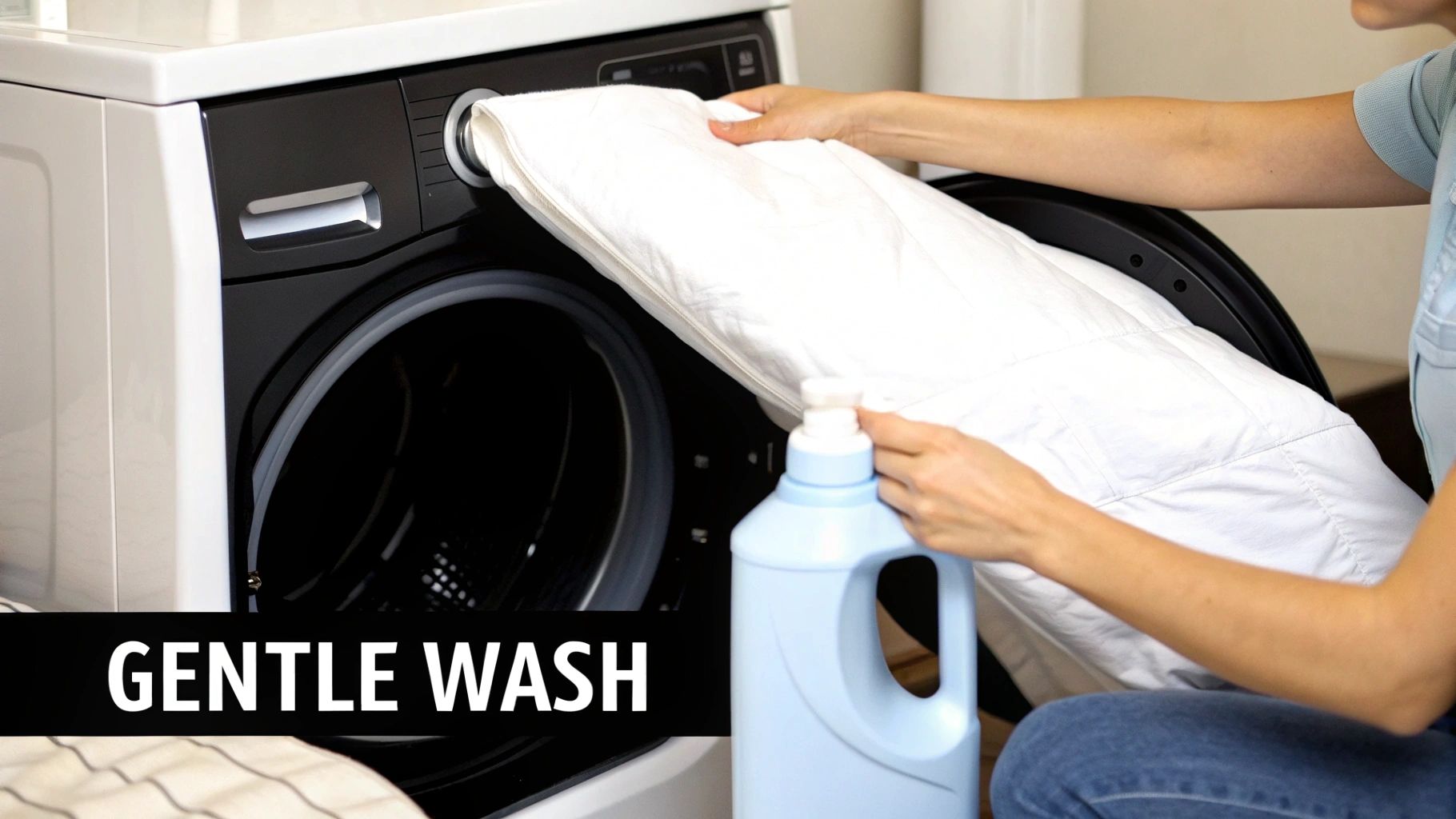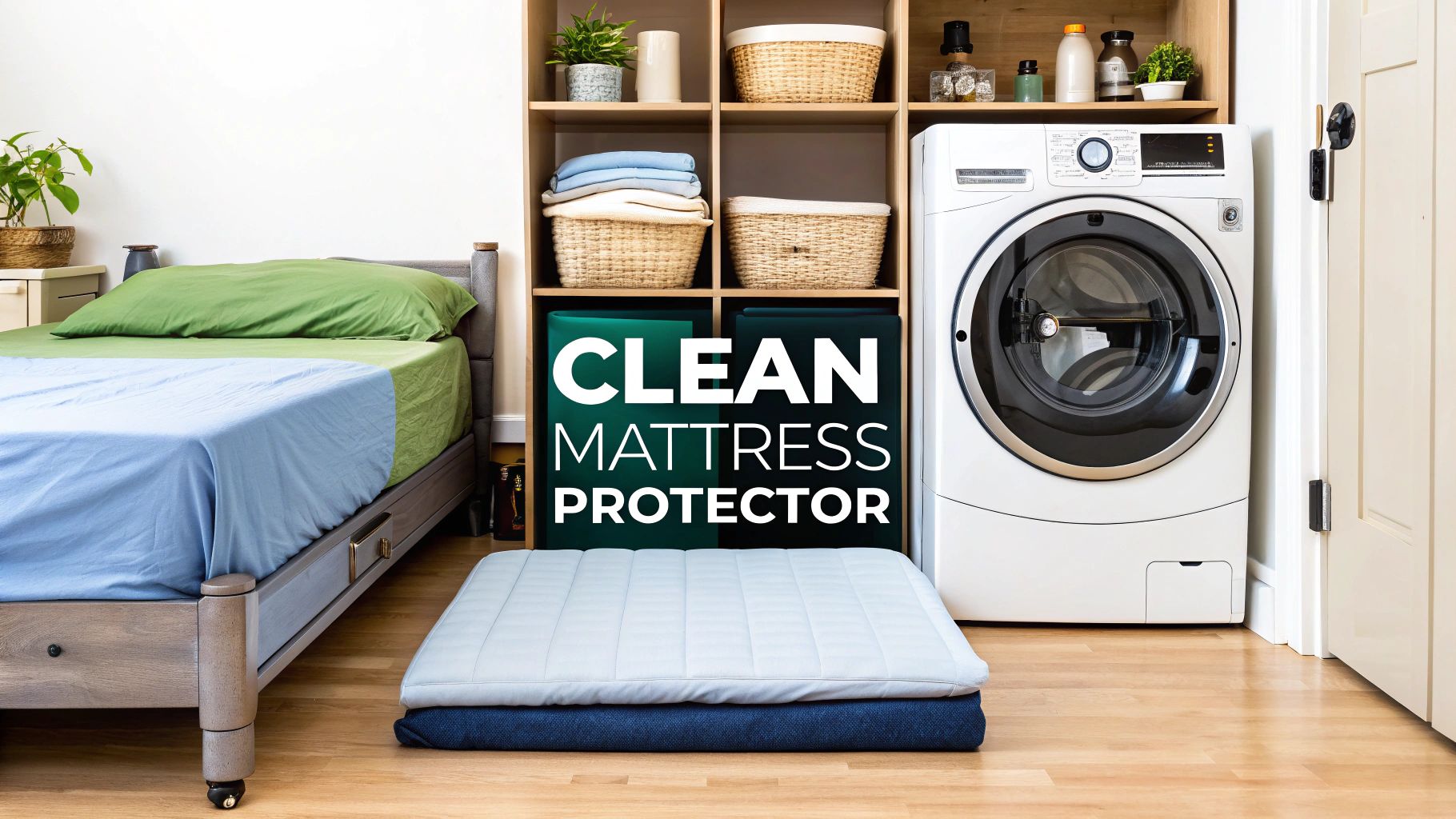Washing your mattress protector is thankfully straightforward. Just pop it in the machine on a cool, gentle cycle with a mild detergent. It's best to steer clear of harsh chemicals like bleach. Most can be tumble dried on a low heat setting, but it is always wise to give the care label a quick check first to be safe.
Why a Clean Protector Is Your Bed's Best Friend
Think of your mattress protector as the unsung hero of your bedroom. It works quietly night after night to keep your sleep space healthier and more comfortable. While its most obvious job is to fend off spills and stains, the benefits go much further, playing a key role in your family's wellbeing.

It is the first line of defence for your mattress, catching all the things you would rather not have sinking into the fibres. This includes more than just the occasional accident.
- Invisible Allergens: Dust mites are a big one, but so are pet dander and pollen. These can build up surprisingly fast, often triggering allergies and leading to a restless night.
- Nightly Build-up: It is completely natural, but we all perspire and shed skin cells while we sleep. Without a protector, this creates an inviting environment for bacteria to thrive.
- Accidental Spills: From a morning cup of tea that goes astray to a child's nighttime accident, a protector provides that crucial waterproof barrier against lasting damage and odours.
Giving your protector a wash every one to two months is a simple habit that makes a huge difference. It keeps the build up of dust mites and skin cells in check, which is a major issue for the approximately 21 million people in the UK who suffer from allergies. A regular wash also stops moisture from seeping through, which can cause the materials in your mattress to break down over time.
A clean mattress protector is a cornerstone of good sleep hygiene. It is a simple, practical step that ensures the environment where you spend a third of your life is as clean and healthy as possible.
This small chore pays off massively in terms of both comfort and health. For anyone interested in the wider benefits, it is worth reading about the importance of regular mattress cleaning for better sleep and health. At the end of the day, keeping this essential layer clean is a fundamental part of turning your bed into a restful sanctuary.
Setting the Right Washing Schedule for Your Home
Working out how often to wash your mattress protector is not something you should have to guess. The key is to find a simple, consistent routine that keeps your bedding fresh and hygienic without adding another stressful chore to your to do list.

As a general rule of thumb, washing your protector every one to two months works perfectly for most households. This strikes the right balance, keeping dust, sweat, and allergens in check without feeling like a constant task.
But life is not always one size fits all, and your laundry schedule should reflect what is happening in your home. Some situations definitely call for more frequent washing to ensure your bed remains a healthy, clean sanctuary.
When to Wash Your Protector More Often
Take a moment to think about who is using the bed and what your daily life looks like. You will probably want to pop the protector in the wash more often in these common scenarios:
- Allergy Sufferers: If you are sensitive to dust mites, pollen, or pet dander, washing the protector every two to three weeks can make a world of difference in reducing your symptoms.
- Pet Owners: We love them, but our furry friends bring hair, dander, and the occasional mucky paw print into bed. A wash every few weeks is a smart move.
- Children’s Beds: From potty training accidents to general grime, children's beds need a bit more attention. More frequent washing helps keep their sleeping space clean and hygienic.
Your Guide to Washing Frequency
To make it even simpler, here is a quick reference guide to help you decide what is best for your household.
| Situation | Recommended Washing Frequency |
|---|---|
| General Use (Adults) | Every 1-2 months |
| Allergies or Asthma | Every 2-3 weeks |
| Pets on the Bed | Every 2-4 weeks |
| Illness or Spills | Immediately |
| Guest Bedroom (Infrequent Use) | 2-3 times per year |
This table should give you a solid starting point for creating a routine that works for you.
Of course, a protector on a rarely used guest bed does not need nearly as much attention. Washing it two or three times a year is plenty. A good trick is to add this task to your larger home preventive maintenance schedule so it never gets forgotten.
If you are looking for more detailed cleaning advice, our guide on how to clean a mattress cover dives even deeper into the specifics.
The Best Way to Wash Your Mattress Protector
Keeping your mattress protector clean is about more than just hygiene, it is about preserving its protective qualities. Following the right process ensures it stays fresh and effective, maintaining that crucial waterproof barrier that keeps your mattress in pristine condition.

Before you even think about putting it in the machine, your first port of call should always be the care label. Seriously, do not skip this. That little tag is your personalised instruction manual from the manufacturer, detailing the ideal temperature, cycle, and drying method. Ignoring it is a gamble, as some materials, especially those with waterproof linings, can be surprisingly sensitive.
Gentle Cleaning for Lasting Protection
Once you have read the label, you can get to work. If you are dealing with a fresh stain, like a coffee spill or a little accident from a child or pet, it is always best to pre-treat it before the main wash. You do not need any harsh chemicals for this.
A simple, effective trick is to gently blot the stain with a cloth dipped in cool water and a small amount of mild detergent. The key is to blot, not scrub. Rubbing too hard can fray the fabric fibres and push the stain deeper. Let it sit for about 15 minutes to give the detergent time to lift the mark before you pop it in the wash.
When it comes to the main wash, think gentle. In the UK, the consensus is that a cool, gentle cycle is the best way to clean a mattress protector without compromising the waterproof lining. This typically means washing with warm water, around 40ºC, and using a mild, preferably eco friendly, detergent.
What to Avoid in the Wash
Knowing what not to do is just as important as knowing what to do. Certain laundry products can be the enemy of your protector's special features, particularly that waterproof membrane.
- Bleach and Harsh Chemicals: Steer clear of these. They are far too aggressive and can break down the waterproof layer, rendering your protector useless. They can also cause ugly discolouration.
- Fabric Softeners: They might make things feel soft and smell nice, but fabric softeners leave a residue that can clog the pores of the fabric, which ruins its breathability and protective qualities.
- High Temperatures: This is a big one. Washing or drying on a high heat setting can shrink the material or, even worse, melt the waterproof backing, causing it to crack, peel, and lose all its power.
Think of your protector's waterproof layer like a delicate raincoat. You would not throw a high tech coat in a boil wash with harsh chemicals, and the same principle applies here. Gentle care is the secret to a long and effective life.
By choosing a mild detergent and a cool, gentle cycle, you are protecting your investment. This simple routine does not just get it clean, it preserves the very features that make it so essential. A well cared for protector works with your bedding to create the perfect sleep environment. Speaking of which, you might find our guide on the best material for bed sheets useful.
Drying Your Protector Without Causing Damage
Getting your mattress protector clean is only half the battle, how you dry it is just as crucial. The wrong drying method can shrink the fabric or, even worse, melt the waterproof backing. Once that happens, your mattress is left completely vulnerable. High heat is the real culprit here, so a gentle touch is non negotiable.

Without a shadow of a doubt, air drying is the gold standard. Hanging your protector out to dry completely sidesteps the risk of heat damage, which goes a long way in preserving its lifespan and protective qualities.
Of course, given the famously unpredictable UK weather, line drying is not always on the cards. If you have to bring it indoors, simply drape it over a clothes airer in a room with good airflow. A top tip is to rotate it every so often. This ensures air gets to both sides, helping it dry evenly and thoroughly.
Using a Tumble Dryer Safely
If time is tight and the tumble dryer is your only option, do not worry, you can use it safely with a bit of care. The golden rule is to keep the temperature right down to avoid any mishaps.
Here is how to do it right:
- Stick to a low heat or no heat setting. It will take a bit longer, but it is the only way to be certain the waterproof membrane will not melt or crack.
- Pop a few dry towels in with it. A couple of clean, dry towels will absorb some of the excess moisture and can actually speed up the whole process.
- Check on it regularly. Do not just set the timer and walk away. It is wise to pause the machine every 20 to 30 minutes to feel how it is getting on and make sure no spots are overheating.
The aim is to get it bone dry before it goes anywhere near your bed. Even a hint of dampness can lead to musty smells or mildew growth, which undoes all your hard work.
Choosing the right drying method is a vital part of your bedding care routine. Each piece, from the protector to the duvet, is made from materials that need specific handling to perform their best. For more on this, have a look at our advice on choosing the best fabric for a duvet cover. By taking these simple precautions, you will keep your protector in top notch condition for years to come.
Common Cleaning Mistakes to Steer Clear Of
We have all made laundry mistakes, but some can unfortunately spell the end for a perfectly good mattress protector. Getting your cleaning routine right from the start not only keeps it fresh but also ensures it lasts for years. Let's walk through a few common pitfalls so you can avoid them entirely.
Turning the Heat Up Too High
One of the most frequent errors is using water that is far too hot. It feels like a logical leap, hotter water means a deeper clean, right? Well, for a mattress protector, it can be disastrous. Excessively high temperatures can shrink, damage, or even melt the waterproof membrane, which completely defeats its purpose.
Reaching for the Wrong Products
It is tempting to grab the bleach or a heavy duty detergent when dealing with a stubborn stain, but please resist the urge. Harsh chemicals can be incredibly destructive, breaking down the delicate waterproof layer and ruining its effectiveness.
Another culprit to avoid is fabric softener. While it works wonders on towels, it can clog the tiny pores in your protector’s fabric, which seriously reduces its breathability.
Overloading and Overspeeding the Machine
We are all looking to save time, and it is easy to think stuffing the washing machine to the brim is an efficient shortcut. For a bulky item like a mattress protector, this is a big mistake. It needs plenty of room to move around and agitate properly, otherwise, the water and detergent cannot do their job, leaving you with dirty patches.
Putting it on a high speed spin cycle can also cause more harm than good.
The intense force of a super fast spin can stretch out the elasticated skirt and put a lot of strain on the delicate fibres of the protector itself. A gentler, slower spin is a much kinder and more effective choice.
By sidestepping these simple mistakes, you will not only get your protector perfectly clean but also preserve the very features that make it so essential for your bed. This careful approach means your investment will continue to shield your mattress for a long time to come.
A Few Final Questions on Protector Care
It is completely normal to have a few lingering questions. When it comes to looking after something that protects your mattress, you want to get it right. Let's run through some of the most common queries we get.
Can I Actually Wash a Waterproof Mattress Protector?
Yes, you can and you absolutely should! The majority of waterproof protectors are made to be machine washable. The trick is to treat them gently. Opt for a cool, gentle cycle and avoid high heat at all costs. Extreme temperatures can damage the waterproof layer, which is the very thing that keeps your mattress safe from spills and stains.
Is It Okay to Use Bleach to Get It White Again?
It is strongly advised against it. Bleach is a powerful whitener, but it is simply too aggressive for the delicate materials in a protector. It can degrade the waterproof membrane over time and, ironically, can sometimes lead to yellowing. A mild, gentle detergent is always your best bet.
What Is the Best Method for Drying?
If you can, air drying is the gold standard. Popping it on a washing line or over a clothes airer is ideal. If you are short on time and need to use a tumble dryer, make sure you select the lowest possible heat setting. High heat can cause the protective layer to shrink or even melt. For the same reason, never, ever iron your mattress protector.
One of the biggest mistakes people make is putting the protector back on the bed while it is still slightly damp. You need to be certain it is bone dry. Any trapped moisture can lead to musty smells and even mildew growth between the protector and your mattress.
Taking a little extra care really pays off, ensuring your protector does its job for years to come. If you have any other questions, you might find the answer you are looking for in our full list of frequently asked questions.
Ready to experience ultimate comfort and protection? Discover the beautiful and practical bedding essentials at Morgan and Reid. Explore our collection and transform your sleep at https://www.morganandreid.com.



Share:
A Quick Guide to Double Bedding Measurements